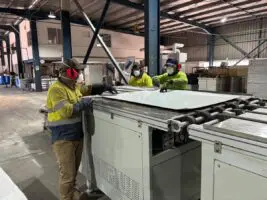If New South Wales councils introduced bans on new-build homes from connecting to the gas network, requiring them to be fully electric instead, these homes would save more than $600 a year on energy costs over their lifetime, a new report has found.
In a study commissioned by 350.org, Strategy Policy Research has modelled the potential economic and environmental benefits of electrifying new residential and commercial buildings in NSW, starting from the new financial year.
The report compares a “business as usual” scenario where new homes and businesses continue to be connected to gas at the current rate, versus a “no new gas” (NNG) scenario where all new homes and businesses are all-electric from July 2024.
It finds that if all NSW councils that are connected to the state gas network required new residential buildings to be fully electric by FY2024, each newly built home would save $608 per year on average, over a typical 40-year life of a building.
- At a household level, this translates to savings of an average of $7,900 over the 40 year period, while a state level the report finds these household would save a collective total to $5.3 billion over the same period of time.
The savings for commercial construction, which covers everything from hospitals to schools to retail shopfronts, from going off gas is $1.3 billion over 40 years.
Using government powers to prevent new-build homes and businesses from connecting to gas networks is not new territory in Australia.
Victoria’s Labor government last year declared that planning permits for new homes and residential subdivisions could only connect to all electric networks, starting in 2024, marking a major about face for the state with the highest residential gas use in Australia.
Calls for this policy to be adopted in NSW have so far been ignored but, in the absence of state policy, an increasing number local councils have been using their own planning powers to ban new gas connections, in a push for all-electric new homes and businesses led by the 350 Australia campaign.
The Parramatta and Waverley councils were the first, and in 2023 the Lane Cove and Newcastle Councils enforced electrification for new builds in their areas while the City of Sydney, Inner West, Canada Bay, and Ryde Councils started the process.
This week’s report finds that residents in Blacktown in Sydney’s west would get the biggest bang for their buck through electrification, while the city of Sydney tops the list for biggest savings for commercial buildings. They both also top the list for most avoided emissions.
All up, the study covers the 95 local government areas (LGAs) that are connected to gas mainlines in the state, which is about 86 per cent of the NSW population. It doesn’t take into account homes and commercial buildings installing rooftop solar and batteries, which would make the savings gap even larger, but expects housing and commercial stock to slightly more than double over 40 years.
If these LGAs banned any new gas-connected buildings – either residential or commercial – from this year, the total savings from no longer paying for gas or gas connections totals a massive $6.6 billion over 40 years.
The total savings in fiscal 2024 would be $30.2 million alone, finds the report Electric Savings: the case for NSW councils to reduce emissions and energy bills through electrification.
The emissions savings would be a cumulative 39 million tonnes over 40 years, or the equivalent of taking 313,000 cars off the road every year.
The bottom line, says the 350.org report, is that government gas bans represent a “high reward, no regrets policy” that would cost local councils almost nothing, while delivering significant energy bill savings to households and businesses, improving health outcomes, and cutting climate pollution.
“In the report, avoided daily gas connection fees make up around 30 per cent of the cost savings under the model, or $1.6 billion over the 40 year period. The remaining 70 per cent of savings are energy bill savings,” says Better Renting’s Joel Dignam.
“Higher energy costs are a challenge for everyone, especially renters who have little choice but to rent inefficient homes with expensive gas appliances. Having more all-electric homes will mean more options for renters and cheaper energy bills.”
The model takes into account the rate of new residential and commercial construction projections, as well as solar rooftop penetration rates based on the Australian Energy Market Operator’s (AEMO’s) Step Change Scenario in the Integrated System Plan.







